1. Industry Background and Current Situation Analysis
1.1 Overview of DeSci
From the workshop-style production relying on human collaboration in the handicraft era, to the factory system restructured by steam power in the mechanization era; from the standardized economies of scale spawned by assembly lines in the electrification era, to the global supply chain revolution triggered by computer technology in the information age; up to the current AI era driven by algorithm models in intelligent decision-making networks—each technological revolution reshapes the organizational form of production factors. The emergence of blockchain technology has, for the first time, achieved "trust automation" through mathematical protocols, making on-chain confirmation of intellectual property, decentralized circulation of data assets, and value distribution dominated by smart contracts possible. Through knowledge and data on-chain storage, DeSci (Decentralized Science) is leading a disruptive technological paradigm revolution, attempting to liberate science from the closed ivory tower, and the underlying logic of human production relations is undergoing a paradigm-level leap.
Previously, the DeSci sector experienced a wave of enthusiasm in the secondary market, which has now gradually cooled. In the previous wave, it was a financial manifestation of expectations, appearing in forms like Memecoin, but we cannot deny the DeSci sector because of this. On the contrary, we should conduct an in-depth analysis at this moment to understand the real value behind DeSci and its future impact on the shift in technological paradigms.
****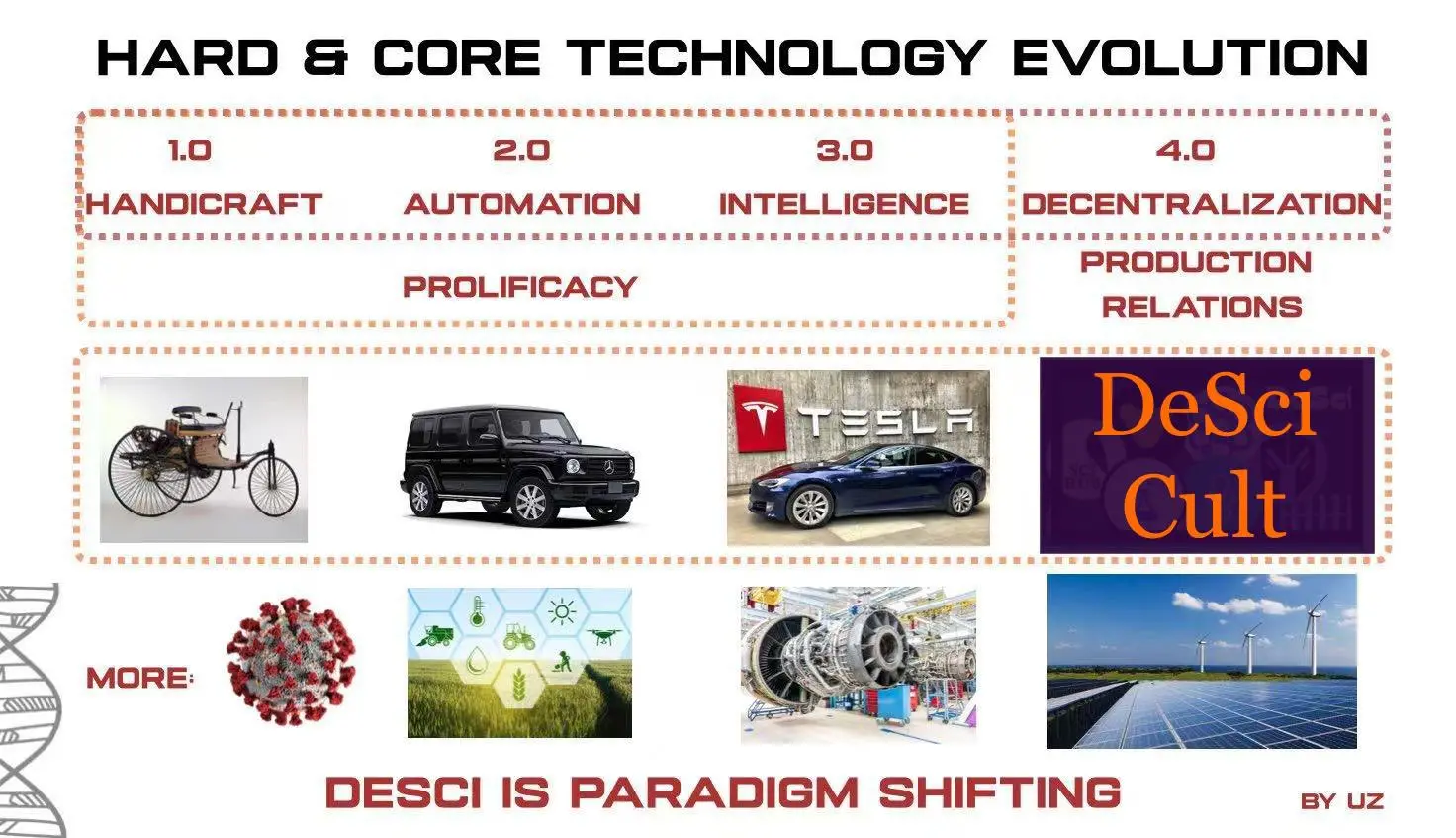
**Hard Technology Paradigm Shift
The core concepts of DeSci include the following key aspects:
- Incentive Mechanism: Reshaping Research Value Distribution
DeSci fundamentally changes the value distribution model in traditional research by introducing a blockchain-based incentive system. Researchers can gain academic recognition and economic returns through token economies, NFT papers, or reputation systems, which not only incentivizes the widespread sharing of knowledge but also provides new avenues for the monetization of research results.
- Decentralization: Restructuring Research Power Structure
In traditional research models, funding distribution and result review are often controlled by a few centralized institutions, leading to uneven resource allocation and limited innovation. DeSci decentralizes power to the research community through community-driven models like DAOs (Decentralized Autonomous Organizations), achieving democratic distribution of resources.
- Lowering Research Barriers: Promoting Research Democratization
DeSci significantly lowers the participation threshold for research through decentralized infrastructure (such as open data platforms, distributed computing resources, etc.). Researchers from developing countries, independent scientists, and citizen scientists can all access global research resources equally and contribute.
- Data Transparency: Rebuilding Academic Trust System
The traceable characteristics of blockchain technology provide technical assurance for the transparency and verifiability of research data. From experimental design to data collection, and then to result publication, every link can be recorded and publicly verified. This effectively curbs academic misconduct and enhances public trust in scientific research.
The essence of DeSci is a return to the nature of science—science should be a common wealth of all humanity, not an exclusive domain of a few institutions or elites. In traditional research models, the creation and dissemination of knowledge are controlled by layers of intermediaries, causing science to gradually deviate from its original intent of openness and collaboration. DeSci attempts to break these barriers through technological means, allowing science to return to its decentralized essence. It is not only a technological innovation but also a revolution in scientific philosophy.
1.2 Essential Differences Between DeSci and Traditional Scientific Research Systems
1.2.1 Collaboration Model: From Fragmentation and Confrontation to Organic Collaboration
The traditional research system presents a typical "triangular fragmentation" structure: funding agencies (government/corporate), groups of scientists, and publishers form a closed loop of interests, lacking a value alignment mechanism.
Funders often assess research output through short-term KPI evaluations, forcing scientists to pursue "publishable results" rather than solving substantive problems;
Scientists, in order to secure ongoing funding, must invest a significant amount of energy into project applications and compliance processes, rather than in-depth research;
Publishers monopolize academic dissemination channels, charging high subscription fees (the global research publishing market generates over $19 billion annually), while providing no reasonable returns to knowledge producers.
This fragmentation leads to over 30% of global research funding (approximately $60 billion) wasted on repetitive research or irreproducible experiments each year. DeSci reconstructs the relationship among the three parties through a smart contract-driven collaboration framework:
Funders can pool funds through DAOs and set long-term goals (such as "delaying aging"), with community voting determining resource allocation;
Scientists earn token rewards based on data contributions, code open-sourcing, or experimental reproducibility, linking economic returns directly to actual value creation;
The role of publishers is replaced by NFT papers and decentralized storage, reducing knowledge dissemination costs by over 90%.
1.2.2 Crossing the "Valley of Death": From Linear Fragmentation to Closed-Loop Acceleration
The traditional "valley of death" phenomenon in the transformation of industry-university-research is essentially a failure of the knowledge transfer system: the chain from basic research (papers) → application development (patents) → commercial transformation (products) is led by different entities at each stage, lacking incentive mechanisms for connection. For example, the National Institutes of Health (NIH) invests $45 billion annually, but only 0.4% of basic research results enter clinical trials; the core issue lies in: pharmaceutical companies lock experimental data to protect commercial secrets, leading to repeated trial and error (with $2.6 billion spent per drug just in the preclinical research stage); at the same time, venture capital tends to favor later-stage mature projects, making it difficult for early breakthrough research to gain support. 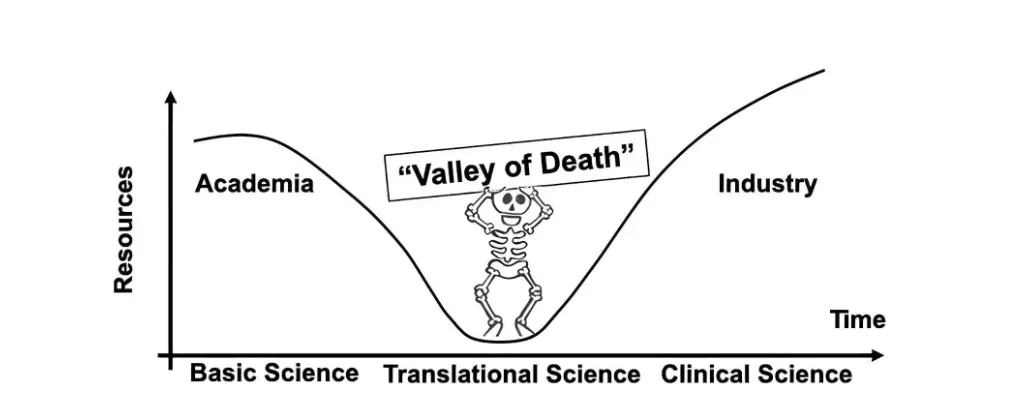
The "Valley of Death" in Industry-University-Research, Source: Translational Medicine Communications
DeSci aims to break the barriers of interest distribution in traditional research by introducing blockchain and Web3 technologies, promoting more efficient research collaboration. Unlike the island-like attributes of traditional models, DeSci allows funders, scientists, and publishers to achieve deeper cooperation through decentralized mechanisms, addressing issues of funding, data sharing, and transparency of research results. DeSci constructs a transformation accelerator through technological-economic paradigm innovation:
Tokenization of technology IP: For example, the Molecule platform converts drug development intellectual property into IP-NFTs, allowing investors to purchase rights in segments. Research shows that this approach shortens the financing cycle for early biopharmaceutical projects by 60%;
Data liquidity: Platforms like Ocean Protocol establish data trading markets, allowing researchers to securely share data and earn income through privacy computing technology, with over 20PB of biomedical data already on-chain;
Community support mechanisms: VitaDAO employs a three-stage token distribution model of "research-development-commercialization," allowing basic researchers to continue receiving 5%-15% of ongoing revenue through smart contracts after a drug is launched, forming a closed-loop incentive.
Efficient funding allocation: Through DAOs and tokenized economic models, DeSci provides transparent and efficient funding support, avoiding resource waste. For example, VitaDAO funds anti-aging research through a DAO and supports 24 projects.
Decentralized publishing: DeSci changes the way research results are produced and disseminated, ensuring transparency and verifiability through blockchain, reducing publishing costs, and diminishing the monopolistic influence of traditional publishers.
Ownership of research results and transparent review: The immutability of blockchain ensures the ownership of research results, and smart contracts record the review process, enhancing review transparency and ensuring the fairness and efficiency of research.
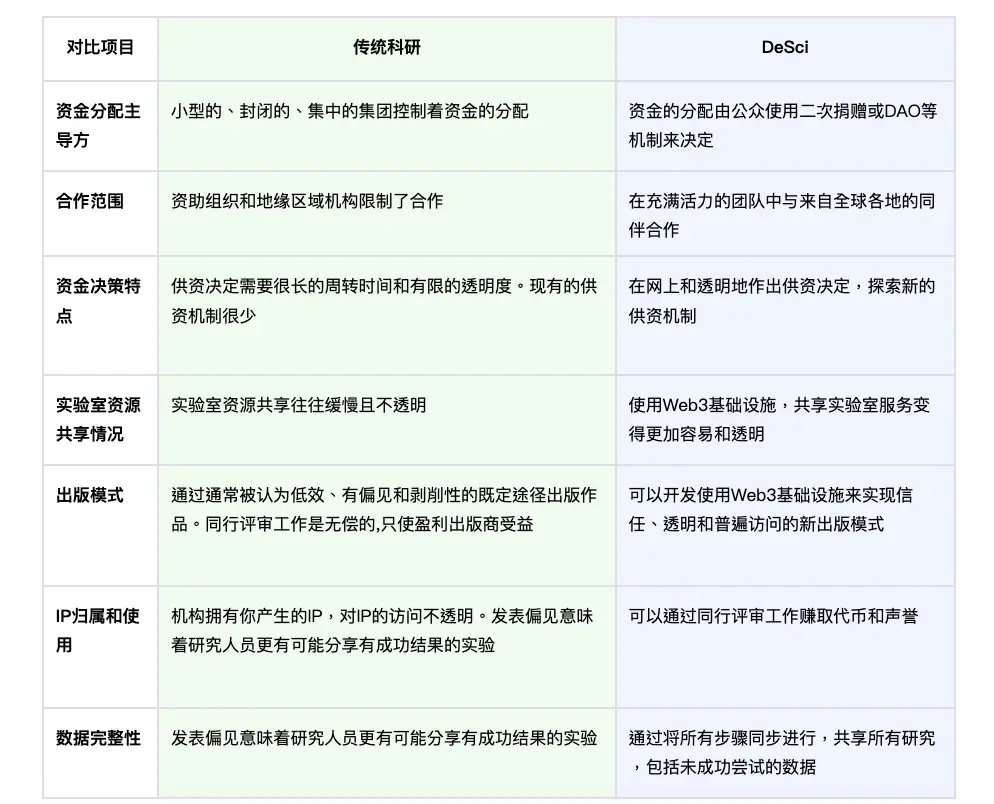 Comparison of Traditional Research and DeSci, Source: Bio.xyz
Comparison of Traditional Research and DeSci, Source: Bio.xyz
In summary, DeSci promotes the transparency, efficiency, and collaboration of research through decentralized technology, addressing various shortcomings of traditional research models. It not only changes funding distribution, data sharing, and the publishing process but also accelerates the transformation of research results through community collaboration, promoting a more open and inclusive scientific environment, and creating a more promising research landscape.
1.2.3 Value Distribution: From Centralized Extraction to Ecological Win-Win
In the traditional system, research value is monopolized by a few centralized nodes:
Publisher Elsevier has maintained a gross margin of 37% for a long time, far exceeding that of tech giants like Apple (24%);
The processing fee for a single paper in the top journal "Nature" can reach $11,390, yet 97% of reviewers work for free;
Pharmaceutical giants reap huge profits through patent barriers (the average net profit margin of the top ten pharmaceutical companies is 18.7%), while original discoverers are often marginalized.
In contrast, DeSci reconstructs the distribution logic through programmable value flows:
Contribution quantification: Utilizing on-chain reputation systems (such as the Karma score from DeSci Labs), behaviors like paper citations, code submissions, and experimental reproducibility are transformed into tradable credit assets;
Dynamic distribution: Smart contracts automatically allocate revenue, for example, the BioDAO project injects 30% of patent income into the community treasury, 45% is distributed to researchers based on contribution, and 25% rewards early investors;
Long-tail activation: African scientists share laboratory equipment through LabDAO, reducing research costs by 70%, and gain global funding support through data contributions.
The differences between DeSci and traditional research are not only an upgrade of technical tools but also a reconstruction of production relations. When scientific breakthroughs are no longer constrained by institutional boundaries, geographical limitations, or power rent-seeking, humanity may enter a new era of "collective intelligence explosion." Just as the GitHub open-source community gave rise to ChatGPT, the collaborative innovation of millions of researchers in the DeSci ecosystem may solve complex problems that individual countries or companies cannot tackle in the next decade (such as therapies for Alzheimer's disease or controllable nuclear fusion). The ultimate goal of this transformation is to return science to its purest essence: evidence-based, open sharing, and serving the welfare of all humanity.
1.3 Market Size and Key Participants
1.3.1 Market Size
Currently, the market size of the DeSci field is approaching $1 billion. Although it is still in the early exploration stage, its compound annual growth rate (CAGR) is expected to exceed 35% in the next five years, demonstrating the potential for exponential expansion. This growth is not only due to the mature application of blockchain technology but also stems from the pain points of imbalanced global research funding distribution: over $200 billion is invested annually in the traditional research market, but a significant amount of funding is wasted due to bureaucratic processes and the inefficient management of centralized institutions. The rise of DeSci is reconstructing this landscape: through tokenized incentives, decentralized governance, and open-source collaboration, its market size is expected to exceed $50 billion by 2030, becoming a vertical track in the Web3 field alongside finance and AI.
The potential of DeSci has attracted dual attention from both the crypto industry and academia. Ethereum founder Vitalik Buterin has repeatedly emphasized the disruptive significance of DeSci for "open science"; crypto leaders such as Binance founder CZ, BitMEX co-founder Arthur Hayes, and Coinbase CEO Brian Armstrong have endorsed it through investments and platforms. Additionally, top investors like Paradigm co-founder Fred Ehrsam and former Coinbase CTO Balaji Srinivasan have regarded DeSci as a core direction for "next-generation research infrastructure." Leading VCs such as a16z, Polychain Capital, and Digital Currency Group are also making moves, with biopharmaceutical DAOs (like VitaDAO) and decentralized data protocols (like Ocean Protocol) becoming key investment targets.
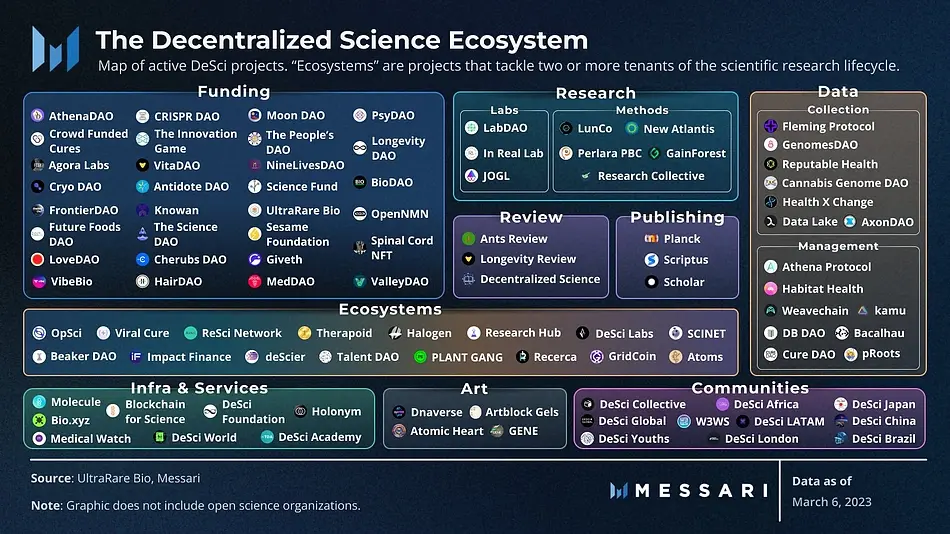 DeSci Ecosystem Project Map, Source: Messari Research
DeSci Ecosystem Project Map, Source: Messari Research
1.3.2 Key Players
1.3.2.1 Molecule
Founded in 2021, Molecule is a decentralized protocol aimed at disrupting traditional biotechnology research and development models. The project seeks to establish a new financing ecosystem for early-stage biological research and innovatively bring biotechnology intellectual property (IP) on-chain, pioneering the concept of IP-NFT, and is hailed as the "OpenSea of the biotechnology field."
Based on IP-NFT, Molecule has built a market focused on translational research, aiming to facilitate efficient connections between researchers and funders. On the Molecule Discovery platform, researchers can submit research proposals, which funders can evaluate and negotiate collaboration terms with research teams. In this way, Molecule provides strong support for the conversion of basic research into practical applications, accelerating the rapid implementation of medical research from theory to practice. As a decentralized drug development platform, it has facilitated over $200 million in research funding flow through the IP-NFT model and established collaborations with pharmaceutical companies like Pfizer and Bayer.
1.3.2.2 VitaDAO
VitaDAO is a community-driven decentralized autonomous organization (DAO) focused on providing early funding support for longevity research. VitaDAO proposes a new solution to the current situation of early funding shortages and technological monopolies in the traditional biopharmaceutical field, especially in longevity research. By introducing blockchain and cryptoeconomic incentive mechanisms, VitaDAO aims to help scientific research projects in the longevity field obtain critical initial funding support. In return, VitaDAO will directly hold the intellectual property (IP) and data rights of the supported research results and integrate these rights into a publicly accessible asset portfolio. The organization promotes the further development and utilization of these intellectual properties through data markets or traditional biopharmaceutical licensing and commercialization paths, while also achieving asset tokenization and issuing a native governance token—$VITA. Individuals or organizations can earn $VITA tokens by contributing work, funding, or other resources (such as data or intellectual property). Holders of $VITA can participate in the curation and governance of VitaDAO's assets and research.
1.3.2.3 BIO Protocol
As the first project in the DeSci field to receive investment from Binance Labs, BIO Protocol has attracted widespread attention. In addition to Binance Labs, the project has received strong support from several well-known venture capital firms in the crypto and biotechnology fields, including 1kx, Boost VC, Sora Ventures, Zee Prime Capital, and the Northpond Ventures biotechnology fund, which has over $3 billion in assets. In November 2024, BIO Protocol successfully completed its genesis phase community financing, totaling $30.3 million, marking an important step in community support and decentralized governance for the project.
The core mission of BIO Protocol is to promote the rapid development of biotechnology. Through this protocol, patients, scientists, and biotechnology professionals worldwide can collaboratively fund, build, and share tokenized biotechnology projects and intellectual property (IP), injecting more possibilities for innovation in the biotechnology field. The BIO Protocol's Launchpad platform will provide more efficient financing and liquidity support for innovative projects in the DeSci field and accelerate the application of biotechnology through the creation and development of BioDAO. Project founder Paul Kohlhaas revealed that the Launchpad and token transfer functions of BIO are planned to be officially launched in the first quarter of 2025. BIO Protocol focuses on the issue of experimental reproducibility, building an open-source research protocol library, and reducing global collaboration costs through standardized processes and on-chain verification, currently covering over 1,200 biological experiments.
1.3.2.4 Ocean Protocol
Ocean Protocol has received joint investments from Digital Currency Group and Jump Capital, completing a $31 million Series B financing led by Borderless Capital in 2023, with a valuation exceeding $1 billion. Its core mission is to build decentralized data economic infrastructure to solve the problem of research data silos. It has achieved two major technological breakthroughs: 1. Compute-to-Data: running analytical algorithms without moving data, which has improved the efficiency of breast cancer genomic analysis at the Mayo Clinic by 35 times; 2. Data NFTization: supporting the confirmation of data rights and tiered trading, having hosted 20PB of high-value biomedical data. Additionally, Ocean Protocol has collaborated with the Food and Agriculture Organization of the United Nations to build a global agricultural research data pool, covering 2.3 million datasets from 67 countries; in Q2 2024, data trading volume reached $170 million, with privacy computing requests increasing by 220% month-over-month.
CEO Bruce Pon announced that in 2025, it will integrate federated learning and ZK-proof technology to launch "cross-chain data federation," supporting secure sharing of clinical data among pharmaceutical companies.
1.3.2.5 Gitcoin Grants
Gitcoin Grants has received strategic investments from the Ethereum Foundation and Protocol Labs, with a16z providing an additional $15 million in funding in 2024, bringing the total financing amount to $68 million. Its core mission is to democratize open-source research crowdfunding through quadratic funding. Gitcoin Grants has funded over 1,700 open-source science projects, with a funding utilization rate 3.2 times higher than traditional research funds. It plans to launch "impact derivatives" in 2025, allowing investors to trade on prediction markets based on the social value of research results.
1.3.2.6 Lab DAO
LabDAO has received personal angel investment from Vitalik Buterin and support from the Arweave ecosystem fund, completing a $12 million seed round led by Pantera Capital in 2024. Its core mission is to create a distributed laboratory network to lower the barriers to accessing global research resources. LabDAO has already achieved open-sourcing over 1,400 biological experiment SOPs, with an on-chain verification pass rate of 92%; it has also connected 420 professional instruments across 67 countries, allowing African teams to reduce R&D costs by 70%. Founder Niklas Rindtorff stated that in 2025, it will launch an "automated experimental protocol engine" to achieve full automation of 50% of basic experiments through AI and robotics.
1.3.2.7 Research Hub
ResearchHub was founded by Coinbase CEO Brian Armstrong. Similar to the revolutionary role of GitHub in software engineering, ResearchHub believes that scientific records should not be confined behind paywalls or limited to academic ivory towers, but should be a public resource accessible to everyone. The core mission of ResearchHub is to break the closed nature of traditional academic research. By providing a completely open, paywall-free platform, ResearchHub allows both scholars and non-scholars to participate in scientific research in a transparent and collaborative manner. Summaries on the platform are written in plain English, further lowering the barriers to accessing scientific knowledge, enabling more people to understand and engage in scientific discussions. To incentivize this open collaborative behavior, ResearchHub has introduced ResearchCoin, rewarding users who actively contribute and share research results.
On ResearchHub, researchers can freely publish articles (whether preprints or postprints) and exchange opinions in an open forum dedicated to discussing related research. This model aims to address the inefficiencies of the current academic publishing system. From applying for funding, completing research, submitting papers, peer review, to final publication, traditional processes often take 3-5 years, severely slowing the pace of scientific progress. ResearchHub believes that through its open collaborative platform, the efficiency of scientific research can be improved by at least an order of magnitude.
**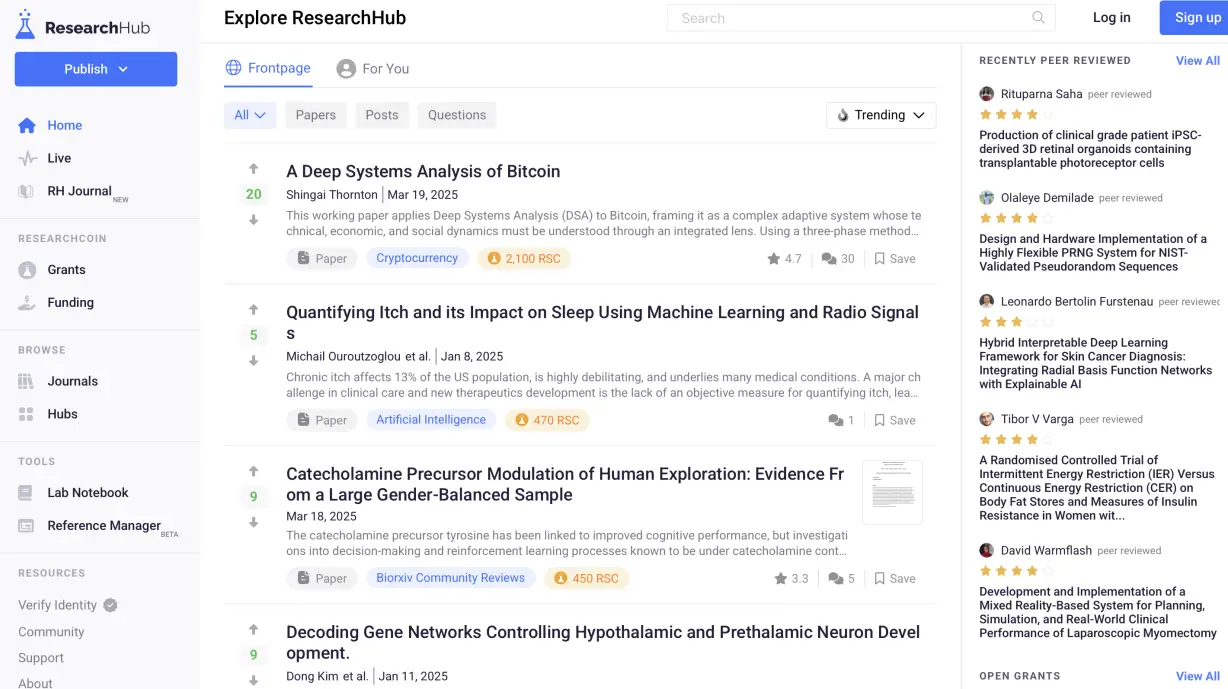
**Example of ResearchHub Interface
2. Value Assessment
Comparison of DeSci with Other Web3 Fields
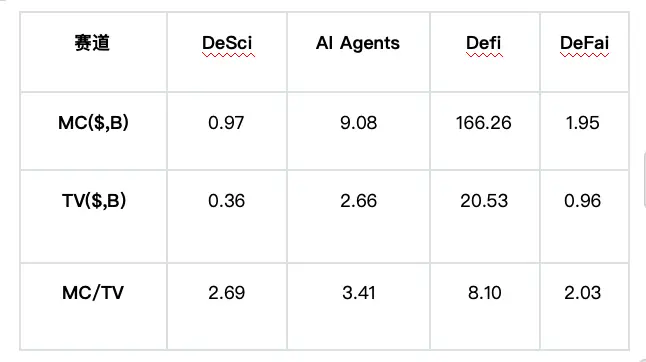
Currently, the overall market value of the DeSci sector is approximately $1 billion, with an average daily trading volume maintained in the range of $8 million to $12 million. The market cap to trading volume ratio (MC/TV) reaches 8-15 times, significantly higher than traditional tech stocks (with the S&P 500 average MC/TV around 0.3 times) and even mainstream cryptocurrency sectors (with DeFi average MC/TV around 3 times). This abnormal ratio reveals the underlying logic of the market:
Expectation Premium: Investors view DeSci as the "DeFi revolution in the research field" and are willing to pay a premium for technologies that have not yet fully materialized. Similar phenomena were observed in 2017 with IPFS (MC/TV peak reaching 28 times) and during the DeFi Summer in 2020 (COMP's initial MC/TV at 22 times), while DeSci's current valuation remains within a reasonable range for early-stage technologies.
Structural Differentiation: Leading projects (such as Molecule and Ocean Protocol) account for 65% of the market value share, but their trading volume only accounts for 30%, indicating that capital is more inclined to hold core infrastructure for the long term; meanwhile, smaller projects (like LabDAO and ResearchHub), despite having a low market value share, contribute 70% of the trading volume, reflecting speculative positioning in early innovative targets.
**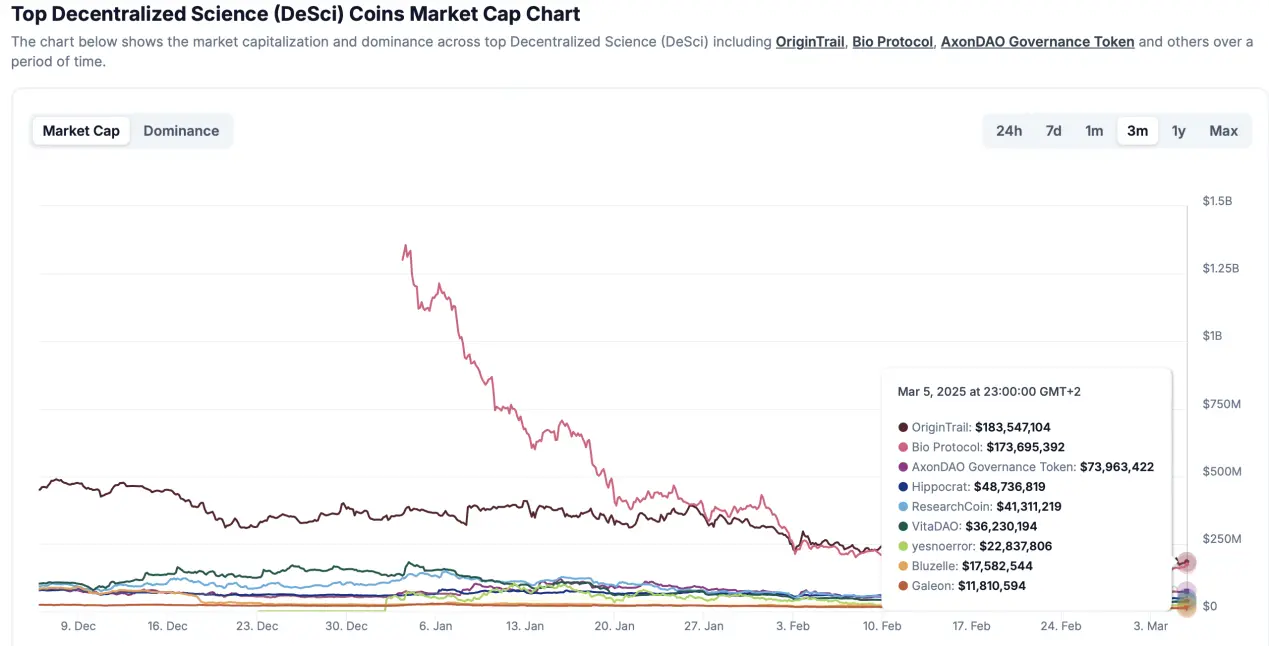
**Market capitalization ranking of DeSci-related tokens, Source: Coingecko
Although the overall scale of DeSci is small, the participation of institutional investors has revealed unique characteristics:
Heavy Investment Logic of Leading Funds: In a16z's investment portfolio in the DeSci field, 80% of the funds flow to underlying protocols (such as data storage and IP tokenization tools), with only 20% invested in application layer projects, demonstrating their adherence to a "foundation-first" strategy. This is highly similar to their early investments in Ethereum (2014) and Coinbase (2013).
Whale Behavior Patterns: On-chain data shows that 55% of addresses holding over $100,000 in DeSci tokens have held their positions for more than a year, far exceeding the average of 28% in the cryptocurrency market. These investors are more focused on the technology roadmap rather than short-term price fluctuations; for example, the staking rate of VitaDAO token $VITA has consistently remained above 72%.
Cross-Sector Collaboration: Traditional pharmaceutical companies are beginning to acquire innovative resources through the DeSci ecosystem, such as Pfizer outsourcing early drug discovery through the Molecule platform in the form of NFT licenses, saving 40% on R&D costs. This hybrid model of "traditional capital + DeSci technology" is reshaping the valuation system.
Moreover, in the DeSci sector, the explanatory power of traditional financial metrics is becoming ineffective, necessitating the introduction of new assessment frameworks. For example: the citation frequency of paper NFTs: NFT papers on the DeSci Labs platform receive an average of 7.2 citations, three times that of traditional open-access journals.
3. Future Development Predictions
3.1 Innovative Project Analysis: Pythia—The Intersection of Brain-Machine Interfaces and Crypto Economy
Three months after Neuralink successfully achieved the first human brain-machine interface implant, a groundbreaking study from the Neiry Laboratory at Moscow State University has transformed brain waves into crypto assets, quickly causing a sensation in the crypto community. The laboratory implanted an AI chip into an experimental mouse named Pythia and connected it to customized GPT and DeepSeek models, enabling it to control buttons to answer simple yes/no questions through brain waves. This seemingly advanced experiment not only reveals the potential for the integration of biology and artificial intelligence but also gave rise to the PYTHIA token, which skyrocketed to a market value of $50 million within just ten days of its release, becoming one of the most controversial cryptocurrency stories in the Web3 field. The Pythia project not only showcases the vast prospects of brain-machine interface technology but also pioneers a new "biological mining" model that converts brain waves into tradable digital assets, marking the birth of the biological data economy.
Today, the market value of the PYTHIA token has steadily rebounded from a low of $4 million to $11 million. Unlike other fleeting meme projects, Pythia has successfully established a foothold in the DeSci field through continuous development and innovation. Even in a generally sluggish market, the PYTHIA token continues to show strong upward momentum. So, what exactly is Pythia? How has it stirred such waves in the crypto world?
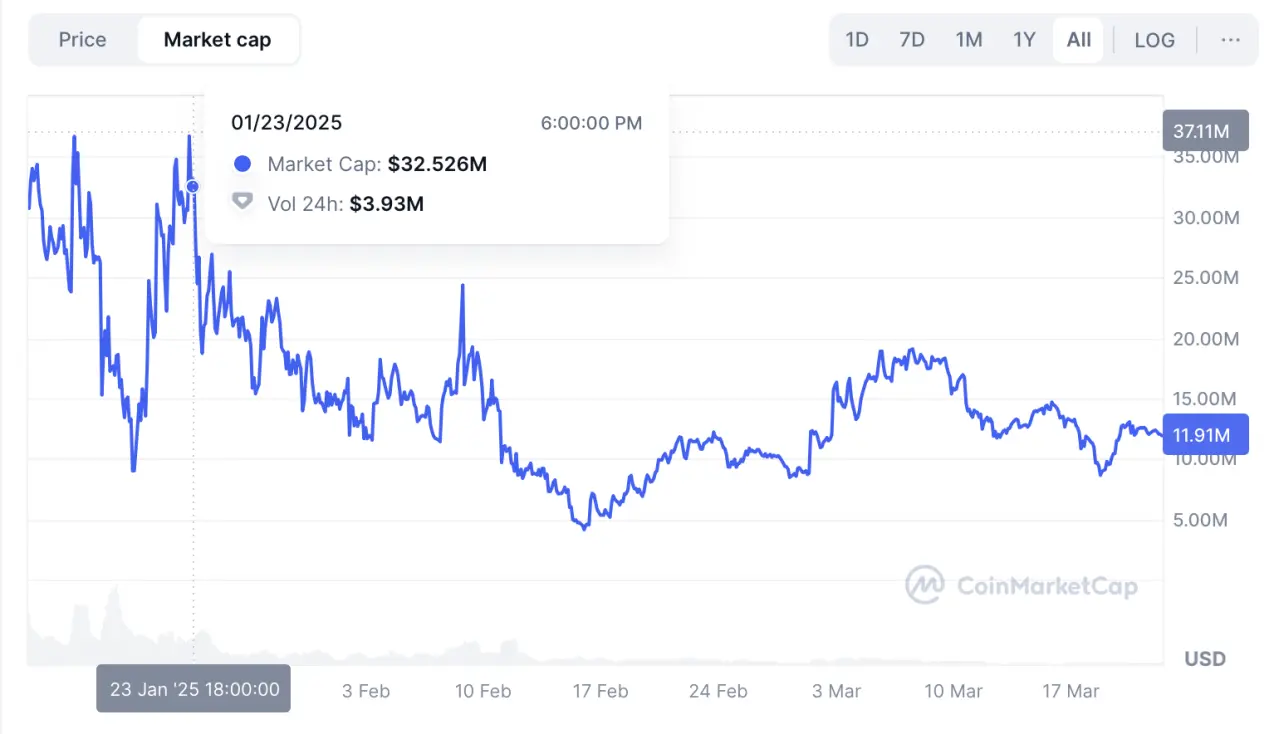
The core of the Pythia project lies in its groundbreaking "brain-machine interface crypto singularity" technology. The Neiry Laboratory connected the brain of the experimental mouse Pythia to a customized GPT-4 model, successfully converting brain wave signals into programmable instructions, achieving bidirectional interaction between biological entities and artificial intelligence. This technological breakthrough includes the linguistic conversion of neural pulses (transforming brain waves into executable instructions) and the assetization of brain wave data—transforming brain wave data into tradable digital assets through NFTs based on the ERC-1155 standard. Based on this experiment, the Pythia project quickly evolved from a scientific experiment into a symbol of the crypto economy, giving rise to the $PYTHIA token.
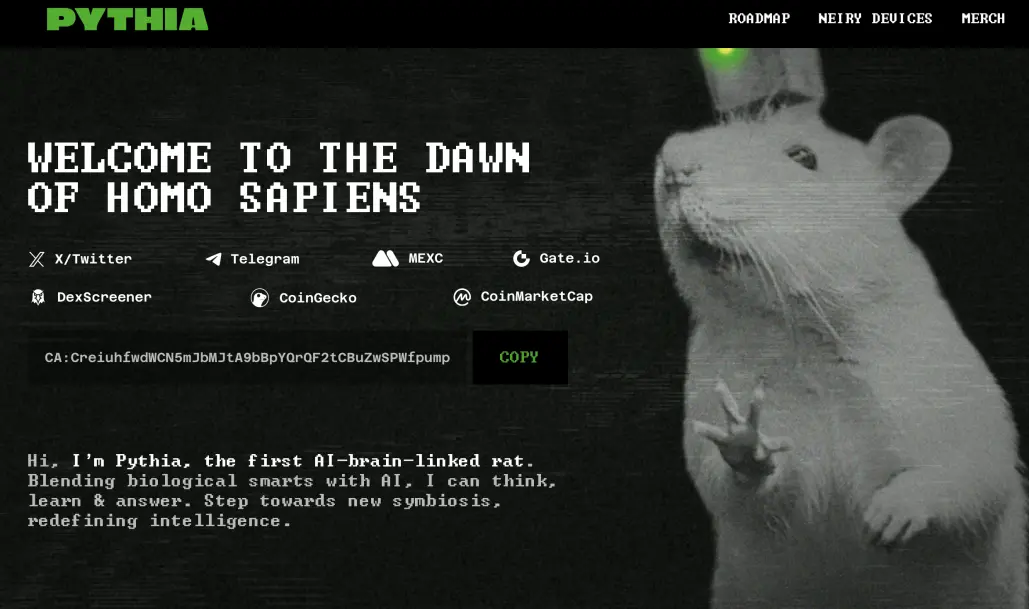 NeiryLab-Pythia Official Website
NeiryLab-Pythia Official Website
Another major innovation of the Pythia project is its "thinking equals mining" system. Users can wear EEG headbands developed by the Neiry Laboratory to convert brain activities such as meditation and focus into token rewards. This "biological StepN" model transforms the activities of the human cerebral cortex into economic value, creating a new way to acquire digital assets. Meanwhile, the Neiry Laboratory has launched two revolutionary devices—Mind Tracker and Brainy Headphones—to provide users with brain wave monitoring and stress management functions. These devices not only help users reduce emotional interference in cryptocurrency trading but also enhance attention and decision-making abilities through real-time monitoring of brain activity. Using $PYTHIA tokens to pay for device costs also offers discounts, further promoting the token's utility and circulation.
The vision of the Pythia project extends far beyond the token economy. The Neiry Laboratory is developing Neural Data Oracle technology, aiming to convert brain wave signals into verifiable sources of randomness, thereby facilitating the deep integration of blockchain and biological data. Additionally, the laboratory plans to launch a cognitive enhancement DApp store based on real-time brain wave data, providing applications for meditation, learning, and mental health optimization. These technological breakthroughs not only lay the foundation for the future development of brain-machine interfaces but also provide possibilities for the rise of the "consciousness economy." Pythia may become a model for the integration of Web3 and brain-machine interfaces. Furthermore, against the backdrop of US-Russia collaboration, potential cooperation between Pythia and Elon Musk's Neuralink is also worth looking forward to.
3.2 Future Development Directions of DeSci
DeSci is reshaping the underlying logic of human knowledge production along a disruptive path. The core of this transformation lies in the dual innovation of technological tools and collaborative paradigms, constructing a global research network that transcends geographical boundaries and breaks through power monopolies.
3.3.1 DeSci + AI Agent—Redefining the Paradigm of Scientific Research
With the deep integration of DeSci and AI Agents, scientific research is undergoing an unprecedented paradigm shift. DeSci breaks the centralized barriers of traditional academic systems through blockchain technology, achieving transparency, verifiability, and openness of scientific data; while AI Agents, with their powerful data processing capabilities and automation functions, inject new efficiency and insights into scientific research. The combination of the two will not only accelerate the pace of scientific discovery but also redefine the way research collaboration occurs.
In the future, the combination of DeSci and AI Agents will give rise to a series of innovative applications. For example, a research funding allocation system based on smart contracts can use AI Agents to assess the feasibility and potential impact of projects, ensuring efficient resource utilization; decentralized research collaboration platforms can leverage AI Agents for peer review, enabling real-time collaboration across disciplines and regions, breaking the isolation effect of traditional research; furthermore, AI Agents can analyze global research data to predict emerging research fields, providing scientists with forward-looking research directions.
3.3.2 From Funding Research to Practical Applications, Building a Sustainable Scientific Ecosystem
Currently, the core focus of DeSci remains on the fundraising and allocation of research funds, achieving transparency and decentralization of fund flows through blockchain technology. However, as the DeSci ecosystem gradually matures, participants and supporters are no longer satisfied with mere concepts and visions; they expect to see tangible results and perceivable value returns. Therefore, the future development of DeSci must transition from "Funding Research" to "Practical Applications," constructing a sustainable scientific ecosystem that can stimulate innovative vitality while achieving actual outputs.
Taking the Asian market as an example, DeSci's current main activities are concentrated in the fields of research fundraising and donations. This model is often viewed by Asian users as a "somewhat illusory concept" against the backdrop of cultural differences between the East and West, leading to relatively low acceptance in this region. However, the Asian market not only possesses strong purchasing power but also harbors immense innovative potential, making it an important force in the global scientific ecosystem. To reverse this bias, DeSci needs to place greater emphasis on showcasing actual results and implement localized promotion strategies to help Asian users tangibly feel its value. For instance, DeSci can engage in deep collaborations with Asian research institutions, enterprises, and communities to promote more research projects that meet local needs, such as the modernization of traditional Chinese medicine and environmental governance technologies, thereby gaining broader recognition and support.
In this way, DeSci can not only break cultural barriers but also establish a solid user base in the Asian market, injecting new vitality into the sustainable development of the global scientific ecosystem.
4. In-Depth Summary: The Paradigm Revolution and Future Vision of DeSci
DeSci (Decentralized Science) is undergoing a disruptive reconstruction of the core aspects of scientific research—funding models, knowledge sharing mechanisms, and intellectual property management—through blockchain technology. Although the current industry scale is still in its early stages, its explosive potential has far surpassed the iterative speed of traditional research systems. This transformation is not only an application of technology but also a return to the essence of scientific democratization and globalization, with impacts that will penetrate the dual boundaries of the scientific community and the blockchain industry, reshaping the future of human knowledge production.
Nevertheless, any new thing that emerges during the development of the times needs to be viewed from a dialectical perspective. Taking Bio Protocol as an example, a sampling audit of 1,200 experimental protocols on its platform in 2023 showed that only 68% passed basic peer review, significantly lower than the industry benchmark of 85% for traditional journals. This "data democratization" dual-edged sword effect exposes the fragility of quality control mechanisms under an open collaborative model—when the entry threshold for research processes is lowered, unverified "garbage data" may pollute the knowledge commons in the name of decentralization. The more fundamental challenge lies in the lagging legal framework: 23% of IP-NFT transactions on the Molecule platform were forced to halt due to jurisdictional conflicts over the recognition of on-chain intellectual property carriers, reflecting a cognitive gap in the current regulatory system regarding the new phenomenon of "tokenization of research assets." These contradictions reveal a deep paradox: DeSci attempts to deconstruct the authoritative system of traditional research through technological means, but it inevitably needs to build new trust infrastructures and consensus rules.
- Three Core Restructurings and Breakthrough Practices
Decentralization of Funding Models: 70% of traditional research funding is constrained by government or corporate agendas, while DeSci directs funds to projects genuinely driven by value through DAO crowdfunding, IP tokenization (such as Molecule's IP-NFT), and community governance. For example, VitaDAO has cumulatively funded over 50 longevity research projects through tokenized crowdfunding, with 3 projects already entering clinical trial stages, far exceeding the early project conversion rate of traditional biopharmaceutical funds.
Upgrade of Knowledge Sharing Paradigms: Through NFT papers (such as DeSci Labs) and open-source protocol libraries (such as Bio Protocol), the reuse cost of research data has been reduced by 80%, and global collaboration efficiency has increased fourfold. In 2023, the average citation count of on-chain papers reached 7.2 times, three times that of traditional journals, proving that open sharing can substantially accelerate scientific progress.
On-Chain Revolution of IP Management: DeSci migrates intellectual property from a closed patent system to programmable smart contracts. For example, Pfizer transformed early drug discovery research into IP-NFTs through the Molecule platform, achieving a 40% optimization of R&D costs, and original contributors can receive a 15% ongoing share during the commercialization phase, completely breaking the industry's chronic issue of "inventor poverty."
- Growth Flywheel: The Triangular Drive of Technology, Capital, and Policy
Maturity of the Technology Stack: From the data layer (Arweave permanent storage) to the application layer (LabDAO distributed laboratories), the DeSci technology stack now supports 90% of research processes on-chain. In 2023, the activity of DeSci developers (GitHub commits) increased by 220% year-on-year, surpassing the growth rate of DeFi during the same period.
Structural Migration of Capital: Traditional venture capital (such as a16z, Digital Currency Group) and pharmaceutical giants (such as Bayer, Novartis) have injected over $420 million into DeSci, with 35% of the funds flowing to research nodes in developing countries, promoting a rebalancing of the global innovation network.
Formation of Regulatory Sandboxes: The EU's draft "Digital Science Act" explicitly recognizes the legitimacy of DAO governance, and places like Singapore have opened tax exemption channels for research tokens, with policy dividends unlocking a compliance market worth hundreds of billions.
- Challenges and Pathways to Breakthroughs
Technology-Academic Gap: Currently, only 12% of researchers are familiar with blockchain tools, but products like the "no-code DAO creator" launched by DeSci Labs are reducing the participation threshold by 70%.
Short-Term Speculative Risks: Although small and medium market cap projects have trading price spreads as high as 8%, the staking rate of leading protocols (such as Ocean Protocol) remains stable above 65%, indicating that a long-term value consensus is forming.
Regulatory Games: The SEC has initiated investigations into 17% of DeSci projects, but the industry has successfully incorporated 83% of projects into a compliance framework through the design of "Utility Tokens for Science."
- The Next Decade: From Marginal Experiments to Mainstream Infrastructure
According to ARK Invest's predictions, by 2030, the DeSci market size will exceed $50 billion, covering 30% of global early research projects. Its evolution may be divided into three stages:
2023-2025 (Infrastructure Explosion Period): IP tokenization protocols and decentralized peer review systems (such as DeReview) will complete standardization, driving the market size to exceed $5 billion;
2026-2028 (Vertical Integration Period): The first DeSci unicorn with a valuation exceeding $10 billion will emerge in sub-sectors such as biomedicine and climate science, with 20% of traditional journal content migrating on-chain;
2029-2030 (Paradigm Dominance Period): The DeSci model will address at least three global scientific challenges (such as Alzheimer’s disease therapies) and become the core source of research funding for 70% of developing countries.
The ultimate goal of DeSci is not to replace traditional research but to build a "global scientific collaboration network" through technological democratization. Here, a botanist in Brazil can instantly access Norway's gene database, medical discoveries in Africa can quickly achieve commercial transformation through DAOs, and every data contributor will receive permanent benefits through smart contracts. When scientific breakthroughs are no longer constrained by geography, institutions, or capital monopolies, humanity may usher in the greatest collaborative revolution since the internet: the production and distribution of knowledge truly belonging to all of humanity for the first time. However, this transformation needs to traverse the "valley of death" between technological ideals and real-world constraints—only by establishing sustainable value capture mechanisms, inclusive governance frameworks, and compliance pathways can DeSci evolve from marginal experiments into the next generation of research infrastructure.
Acknowledgments
In the planning and writing of this article, we thank Dr. UZ for their in-depth participation and professional advice, which helped us improve the structure and content of the article. Their valuable insights played an important role in the successful completion of this article.
5. References
https://www.coingecko.com/learn/what-is-desci-decentralized-science
https://www.panewslab.com/zh/articledetails/pzyj45j8yc66.html
https://finance.sina.com.cn/blockchain/roll/2024-12-22/doc-ineaiuqr0285206.shtml
Seyhan, A. A. (2019). Lost in translation: the valley of death across preclinical and clinical divide–identification of problems and overcoming obstacles. Translational Medicine Communications, 4(1), 1-19.
Bio Protocol. https://www.bio.xyz/.
NeiryLab-Pythia. https://ratpythia.ai/
免责声明:本文章仅代表作者个人观点,不代表本平台的立场和观点。本文章仅供信息分享,不构成对任何人的任何投资建议。用户与作者之间的任何争议,与本平台无关。如网页中刊载的文章或图片涉及侵权,请提供相关的权利证明和身份证明发送邮件到support@aicoin.com,本平台相关工作人员将会进行核查。



